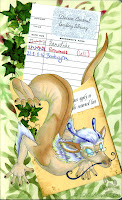Like last year, this year I again contributed to the Brooklyn Art Library "Art House Co-Op" Sketchbook Project! My theme this year was "Prehistoric".
It really took me a long time to get going - I signed up in september and didn't really DO much until I had literally only a week or two before I had to post it. Since my desktop PC fell over, I was finding it hard to get motivated. :(
BUT I filled MOST of my book. :)
Sketchbook
Wednesday, 1 February 2012
Monday, 27 December 2010
At last! Art.
 The bookwyrm. I think he lives in the pocket that library tickets go in? This one clearly needs a better glue.
The bookwyrm. I think he lives in the pocket that library tickets go in? This one clearly needs a better glue. Madame Brushfoot, the missing lepuuri monarch from my Nanowrimo in 2010. I'm still not entirely sure how she ended up IN the bottle. I think Dolorous may have had something to do with it.
Marker, ink, punched paper (the spikey branches) and photographs of bottles printed out on overhead projector paper.
Tsu scatters dried fish across the surface of the pool; hopefully, to keep the hungry sacred sun-marked eel from nibbling on her when she next comes past.
Tried to give it a vaguely egyptian style, to compare with the more Mayan / Aztec influence I gave the other folk. Drawn in pencil on normal drawing paper, scanned and adjusted digitally to emphasize the linework, then printed on papyrus paper (a batch of which I had printed up a while ago) and coloured in markers. I would have drawn directly onto the papyrus paper, except it was really hard to see any pencil work on.
Wednesday, 3 November 2010
Cover
Haha! AND LO, IT BEGINS. ...annd I realise this is the older version of the cover as well. OH WELL.
...and I'm SO LATE about starting, ugh. No I didn't totally forget about it since... June. ^_^ *lies, lies*
I have a few pictures drawn in it, so far, but nothing I have scanned yet.
NO I AM NOT PUTTING OFF MY NANOWRIMO.
Edit: *whoops* Borked the hutmuls.
...and I'm SO LATE about starting, ugh. No I didn't totally forget about it since... June. ^_^ *lies, lies*
I have a few pictures drawn in it, so far, but nothing I have scanned yet.
NO I AM NOT PUTTING OFF MY NANOWRIMO.
Edit: *whoops* Borked the hutmuls.
Friday, 29 October 2010
Sketchbook Tour 2010-2011
Haaa, whoops. I keep forgetting to post this. ¬_¬
This is where I'm (planning to) post my art for my contribution to “the Sketchbook Project: 2011 tour”.
From http://thesketchbookproject.com :
"Thousands of sketchbooks will be exhibited at galleries and museums as they make their way on tour across the country. After the tour, all sketchbooks will enter into the permanent collection of The Brooklyn Art Library, where they will be barcoded and available for the public to view. Anyone - from anywhere in the world - can be a part of the project."
My subject is “Storybook”. I’ll be attempting to remember to post my images to the official website as well as here. At the moment I have SOME ideas and SOME pages drawn, but I need to fill the whole book (a 5.5x8.5 inch Moleskine Cahier, so about 40 sheets/80 pages). More suggestions please!
This is where I'm (planning to) post my art for my contribution to “the Sketchbook Project: 2011 tour”.
From http://thesketchbookproject.com :
"Thousands of sketchbooks will be exhibited at galleries and museums as they make their way on tour across the country. After the tour, all sketchbooks will enter into the permanent collection of The Brooklyn Art Library, where they will be barcoded and available for the public to view. Anyone - from anywhere in the world - can be a part of the project."
My subject is “Storybook”. I’ll be attempting to remember to post my images to the official website as well as here. At the moment I have SOME ideas and SOME pages drawn, but I need to fill the whole book (a 5.5x8.5 inch Moleskine Cahier, so about 40 sheets/80 pages). More suggestions please!
Subscribe to:
Comments (Atom)


